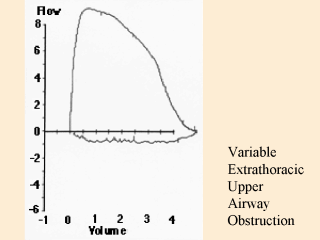 |
As a
result, a variable extrathoracic obstruction primarily affects the inspiratory portion of
the flow volume loop, viewed as a flattening of the usual deep inspiratory curve. The
expiratory portion of the loop appears relatively normal. Conversely, a variable
intrathoracic obstruction mainly affects the expiratory limb, again giving a flattened
appearance to that aspect of the loop. This can be difficult to distinguish from the more
common small to medium sized airways obstruction that characterizes bronchitis, asthma,
and emphysema. Finally, a fixed intrathoracic or extrathoracic obstruction affects both
inspiration and expiration, giving a flow volume loop that has an overall box-like shape
as both inspiratory and expiratory limbs flatten. Variable
extrathoracic obstructions may be caused by vocal cord paralysis, thyromegaly,
tracheomalacia or neoplasm while large airways variable intrathoracic obstructions can
also result from tracheomalacia or neoplasm. Examples of fixed obstruction include
tracheal stenosis, foreign body or neoplasm. |
